

Chapter Two:
A Case for Reference Stds
Chapter Four:
Rum Tasting: The Process
Chapter Five:
A Basic Starter Collection
The Ministry of Rum: Unplugged
Chapter Three:
Tasting and Glasses
Note: this is a long chapter, but worth every single comma. Flockers from the Preacher's cult may choose to skip ahead to seek the true enlightenment of "My Impressions" - paydirt to play in! But understand that conclusions without context is like gravy without mashed potatos. Monkey chow.
Welcome to Chapter Three. No doubt you're tempted to run out and buy the five standards and start tasting. I wouldn't blame you, but I must warn you: the glass you choose and use to taste your rum will make all the difference in the world. Learn from me, the Compleat Idiot. When I first started this adventure I owned but two rums - Mount Gay Extra Old and Ron Zacapa Centenario 23 (both highly regarded) - and just an ordinary short water glass. This glass was about 3 inches in diameter, straight sided (no curvature), maybe 2-1/2 inches high and with the slightest taper inwards.
Nothing special.
I spent a great deal of time tasting both the MGXO and the Zacapa from this ordinary glass and enjoyed them both immensely. Now keep in mind the MGXO can be a challenging rum for the new drinker, exhibiting much complexity and a smooth but powerful finish. It was not long until I decided that I needed a better, more "professional" glass. Soon I owned a Riedel Rum glass, Riedel Single Malt Glass, a short tulip with a flared lip and and last, a short whiskey glass (small base, notable outward taper). Here they are:

(Compare: red and white wine glasses in background)
With the (partial) exception of the short, outwardly tapered whiskey glass, I found I actually disliked, sometimes intensely so, the same rums I'd loved. They seemed harsher, overpowering and almost burned. Yeccchh! What happened? It was then I learned the glass makes a tremendous difference. Consider Reidel's commentary:
| "A person interested in wine is led by color, bouquet and taste, but often the glass is not considered as an instrument to convey the message of the wine. Over the years Riedel acquired some interesting scientific explanations as to why the shape of a glass influences the bouquet and taste of alcoholic beverages. The first discovery was made while enjoying wine. The same wine displayed completely differently characteristics when served in a variety of glasses. The differences were so great that experienced connoisseurs were made to believe that they were tasting a different wine."
"Physical movements and adjustments of head and body are controlled subconsciously. The shape of the glass forces the head to position itself in such a way that you drink and do not spill. Wide, open glass shapes require us to sip by lowering the head, whereas a narrow rim forces the head to tilt backwards so that the liquid flows because of its gravity. This delivers and positions the beverage to different 'taste zones' of the palate." |
Taste zones? And different glasses deliver the rum to different areas of the tongue resulting in different perceptions and tastes?
We'll get back to this later but for now it's enough to know that the most pleasant taste sensation, ie "sweet", receptors are alleged to be more concentrated at the tip of the tongue, "bitter" more at the base, "sour" on the sides, "salt" evenly distributed. Thus, if a rum is delivered more to the tip, pleasant sweet sensations will be maximized. Other researches dispute this analysis stating that all types of receptors appear all over the tongue - and that any differences are ridiculously slight.
However, before we get to taste let's consider aroma - our first and perhaps most important sensation of a rum.
I simply cannot emphasize enough the importance of aroma to rum tasting. Aroma sets the mood and tone, and our expectations. Luis Ayala (The Rum Experience) at his "Rum University" - and most experts - agree that olfaction or aroma is eighty to ninety percent of taste! Unlike tastebuds, the nose can accurately distinguish many hundreds of thousands of odors. And once again, the design of the glass affects your perceptions and enjoyment.
Riedel on aroma and glasses:
| The lightest, most fragile are those reminiscent of flower and fruit and these rise right up to the rim of the glass, while the middle fills with green vegetal scents and earthy, mineral components. The heaviest aromas, typically of wood and alcohol, remain at the bottom of the glass. Swirling the wine in the glass moistens a larger surface area, and this increases the evaporation and intensity of the aromas. But swirling does not encourage different elements of the bouquet to blend together. This in fact explains why the same wine in different glasses shows such an amazing variety of aromas.(The same wine can exhibit fruit aromas in one glass and green and vegetal notes in another). |
Don't panic, I'll soon summarize what I've learned, but first let's review some of the glasses available and what some rum and tasting experts have to say. The world of single malt, like wine, is one of dedicated afficianados and serious tasters. Fine single malts express many of the same aromas as rum. The single malt world has long been established and populated by extremely discerning tasters who have gone to incredible lengths and expense to find and use the perfect glass. As I did with establishing rum reference standards, here are some of the popular groups (credit to the wonderful Malt Madness site):
First, the "Tulip" or "Thistle group:

The Tulip Group
These have a nice "tulip" shaped base with various degrees of narrowing, lengths of neck and type of lip. Second, the "Copita" group. This is a classic, traditional shape adopted by the Single Malt Whisky Society (SMWS):
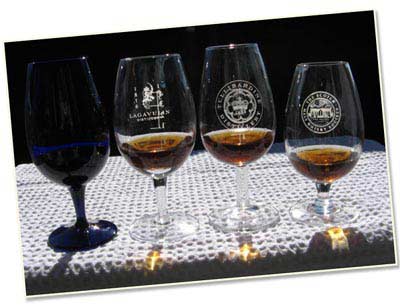
The Copita Group
Third, the Glenfarcas "ISO Standard" group:
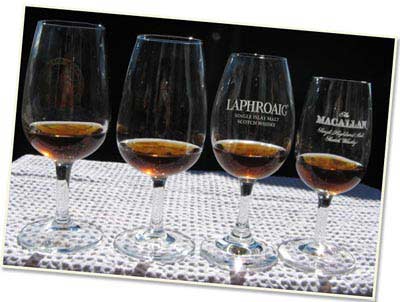
The "ISO Standard" Group
Note that the ISO glasses are simply a taller, less squat version of the SMWS or Copita group. And last, a "Miscellaneous" group:
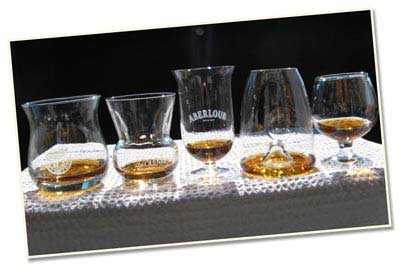
The Miscellaneous Group
Left to right you have the Bruichladdich Wide Bowl tumbler, Glenmorangie (exaggerated) "thistle" glass, Riedel Malt Whisky glass, a glass called the "Concentrator" and finally, a small brandy snifter.
From all these the Malt Madness tester derived these finalists for all around nosing/tasting:
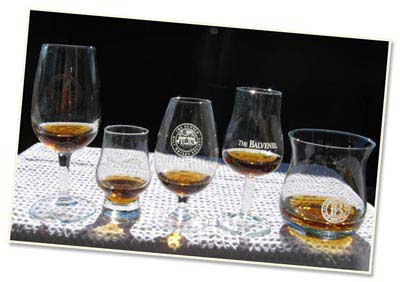
And of these the winner was, envelope please: The good old sherry Copita or SMWS glass, followed by the stretched ISO Standard version. Interesting, eh? Yet when it comes to multiple tastings, the same author has some decided preferences from amoung his rather large collection:
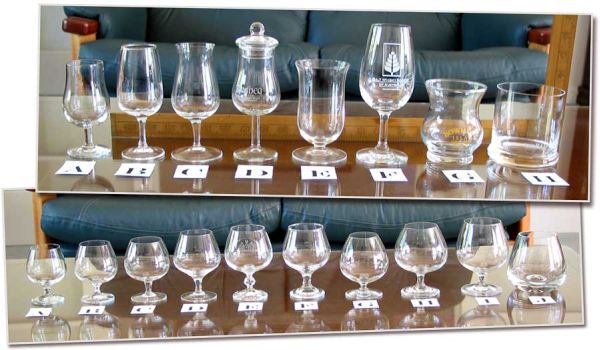
Although he does use the Glenmorangie with cover (top row, "D") to preserve the aroma of side-by-side multiple comparisons, his go-to glass is a small, wider mouth snifter (bottom row, "B") holds 6 oz. He also speaks highly of an Australian glass (top row, "C") for all around evaluation of spirits. His everyday dramming glass: a small/med snifter, 8 oz (bottom row "D"). He prefers enough stem for easy grasping and swirling. Now let's consider another expert glass tester...

1. This is the famous Glenmorangie glass with it's equally famous glass cover, designed to preserve aromas.
2. This is the "ISO" standard tasting glass, a slight taller version of thw SMWS (Single Malt Whisky Society) glass, and similar to the sherry copita glass of which you will frequently hear.
3. The Riedel Single Malt Whisky glass. Pretty, expensive and almost universally disrespected for it's lack of nose (which might be good for very strong spirits).
4. Another Riedel special, the Wine Degustation glass, designed to be laid down and rolled for a very even distribution of spirit on the sides of the glass. Better you should lay it down and roll over it with your car.
5. The Maison du Whisky glass, a kind of modified snifter with a convex bottom designed to better expose the smaller amounts of spirits tasted.
6. A large snifter like the one used by the famous Luis Ayala (The Rum Experience).
These glasses were tested by Klaus Everding, a german taster who publishes in Malt Maniacs. Highest rated was the large snifter for it's "excellent aroma delivery and hand feel", followed closely by the Maison glass which actually delivered better aromas than the so-called "nosing" glasses. He agreed with many others that the ISO standard (like the SMWS glass and sherry copitas) provide a good everyday moderate experience. Not the best, but surely not the worst:
Although the Glenmorangie's cover preserves aromas (so does an index card), he found it the least desireable and "without the lid...would have been the worst". The Degustation, like other glasses intended to greatly concentrate aroma, simply does this too well and can overpower the noser with alcohol aromas (although it may work with very subtle spirits). Too variable. Although the Riedel Single Malt really does improve many single malts and others with very strong aromas, for most the aroma delivery is poor if nonexistent!
There's one final group of glasses that was tested by some truly world famous tasters including Dave Broom (co - editor of Whisky Magazine, and author of "Rum"); Josh Cumming (the Scotch Malt Whisky Society - SMWS), Michael Jackson (Advisory Editor of Whisky Magazine), David Robertson (Master Distiller of the Macallan) and Ian Wisniewski (freelance journalist). Their testing glasses included the SMWS (coppit style), the ISO standard, the Glencairn, the Glenmorangie (cover) and the "Pure" glass (similar to the Maison du Whisky, above, #5). And one other:
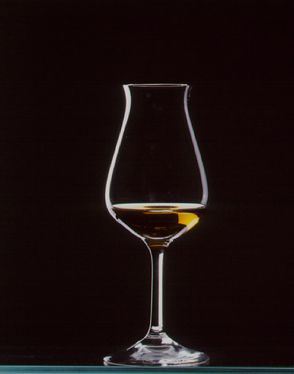
Note that this glass is very similar to the MM Australian nosing glass (large pic, top row, "C") or to the Reidel Rum Glass. The Eisch dominated among these top experts. Here's some email I received from some real rum experts...
| Bilgemonkey:
To be honest, I've never put too much stock in different kinds of glasses when it comes to rum. I've tried brandy snifters, short, squat glasses like scotch is sometimes served in, etc. But in general, I've found the glass that suits me best does so because it feels right, rather than any real impact on the rum appreciation experience. I use a small green chalice like glass that I found at a yard sale. It's cheap and heavy, which I enjoy (never seems right drinking rum from something too delicate.) But what' more, it's a good size. I know exactly how much I can fill it without going overboard. Or, if I do choose to go overboard, I can easily gage just how far overboard I can expect to go. Not elegant, I know. But it works for me. |
| Richard Seale:
The glass I use comes from a technical supply so probably not readily available and not marketed like the glasses you mention. The sherry copita is a favourite of mine and when doing professional tastings with my UK importer we use this glass exclusively.The copita is probably the closest to what I actually use at the distillery. It is very good for a proper evaulation. If you want to use what I use, I do suggest the sherry copita. We also use it when looking at bourbon and cognac. Anything by Riedel is excellent. |
| Dennis at the Rum Portal:
I am not very religious about the glass, as long as it allows me to get the full pleasure of my rum. When I am sitting at home alone or with a few friends I tend to use a tulip-shaped glass (picture attached). It will hold all the flavours, and you can heat the rum up a bit just by holding the glass in your hand. When I am doing tastings I always use the glencairn glasses. They hold all flavours as well, but you cannot heat the rum as easily as with the other glass. So why use them? For 2 reasons: I made a good deal for a lot of glasses, and they won't break so easy - a big plus when doing regular tastings. |
| Johannes van den Heuvel, Malt Madness
Just like with whisky glasses, I imagine that your own nose will be the best judge. Since the glass you chosse will affect every rum you'll enjoy from now on, spending some time to find the perfect glasses for YOU is a wise investment. That being said, my guts agree with Dave (Broom) - copita type glasses should work best. |
| Beach Bum Berry
I use a single-malt Scotch tasting glass (example attached), but I find mine in thrift stores, as Reidel's prices are out of a bum's range ... why? A snifter always connotes cognac to me, and a goblet says wine ... but since a first-class sipping rum can give Scotch a run for its money, and since the flared Scotch tasting glass allows for ample aeration and thus a good nose, it seemed a natural choice to me. |
| Matt Robold: the Dood
Sorry this response took so long. I've actually been thinking about posting this as an "Ask Dood" on the blog, but I need to get some pictures of the glasses I use. I tend to agree with Ed on not using a snifter because with a lot of rums there is simply too much nose to concentrate with the snifter shape. I don't go with a straight-sided glass, rather I go with one that flares outward, so that it's much smaller at the bottom than at the top. |
| Robert Burr of Gifted Rums
I use various glasses. For tasting competitions, the Reidel rum tulip shaped glass is ideal; for rum on the rocks, an El Dorado flared tumbler; my wife Robin likes the little Rums Of Puerto Rico rocks glass. |
| Chris Carllson at Spirits Review
I actually use a couple of different glasses depending on the type and strength of the rum for personal use and one type for reviews. I don't like to use anything particularly delicate or expensive - not that kind of guy I guess for one thing. Second they are too hard to take care of on a boat or on land so I like to use a slightly tulip shaped glass with a decent thickness. Too thin and it warms too quickly and you get too much. I am kind of reluctant to admit it but I have been tending toward the shape you see in the B&B gift pack glasses or a tulip shaped port glass, if you can't find them then a tumbler with a slight inward turn. I always use a slight tulip because it doesn't overwhelm my nose but won't let anything slip by either. It also allows me a slighter wider area to swirl and watch watch happens along with aerate the spirit a bit . I know Ed (Hamilton) uses a glass that looks like a 1/4 size old fashioned - Glencairn is OK if you have a very delicate spirit otherwise can overwhelm too quickly, the Reidels work will if a bit delicate and not great advantage across the board- for good stuff their fine, otherwise a little too much . Also a glass shouldn't cost more than most bottles in my opinion. Snifters can be a little too much also depending on the rum and can't be used across the board so it would throw off my reviews.I try to stick with one glass for each type of spirit for consistency. So I guess the slight tulip for tasting/judging - falls somewhere between Ed and the Glencairn. For my own enjoyment I sometimes will fine tune my glass selection a bit - in other words I will chose the type I thinks works best for the particular rum rather than be consistent for all. Hope that helps a bit. |
| Roger of RnD Reviews:
For your question on rum glasses I would recommend a double old fashion glass or something similar. You want something with a wide opening and not too tall. A brandy snifter would work fine. |
| Ed Hamilton from the Ministry of Rum:
By my mind the top of the glass should be something like the diameter of a 750ml spirit bottle - about 3 inches or 75mm. The reason that I like to use a wide or flared glass is so that I can assess more of the flavors of the spirit. By holding the glass at 45° and moving your nose from the high side of the glass to the lower side you will discover the complexity of the spirit. When using a snifter type glass the aromas are concentrated and more difficult to assess. I also like the feel of a larger glass in my hand and don't like to drink spirits from a glass with a high center of gravity, especially on my boat. |
My Impressions
By now you are thoroughly confused - as was I - so now it's time for the Compleat Idiot - me - to hold fourth, er, forth...
Here are some of my own ruminations:
1. According to Riedel a flared rim tends to deliver spirits to the front of the tongue and may emphasize sweet notes. This is not a bad way to start the tasting part of nosing/tasting.
2. Aromas are divided vertically - lightest/highest (flower/fruit), mid (green vegetal and earthy mineral), and low/heavy (wood, alcohol). This would confirm the Minister's observations and techniques. Swirling increased intensity but not distribution. Does the tulip shaped rum glass hold the lighter aromas in? It surely does not allow you to address the mid and lower levels using Ed's technique (high/low). And when you put your nose in or close to the lip and inhaled it seems as though you draw up the lower levels. Perhaps a more delicate approach. I really found my original wide mouth tumbler more effective.
3. Tasting is in "small or very small" amounts/sips to expose the entire palate. Gulping or going to the back of the tongue too fast accentuates the acid/tart to the loss of sweet/fruit. And sweet is the primary favorable sensation. The rearward head tilt of a narrower glass delivers wine more to the middle and back. Coupled with a flared rim, a glass like the Riedel Rum or the Eisch should deliver rum to both the tip and middle/back, tip favored, emphasizing sweet. This is good.
Compare to a wide tumbler which forces a head forward sip - which will also deliver to all areas of the tongue, butnow with the middle favored. I also question nose involvement with the tumbler, as a head forward sip also implies the noseis actually IN the glass, when compared to the Reidel Rum Glass design. In this case the nose is much closer to the alcohol and heavier aromas when tasting.
4. "Sweet" is our number one motivator and motivator. Releasing sweet is essential for maximizing tasting pleasure - temperature is a major factor with "sweetness" increasing by 40% from refrigerator to body temp. The effect is much greater for lower sucrose concentration (like rum or sugar in coffee) with "sweetness" almost doubling after warming! Point: warming the rum has great benefits. A glass with sufficient stem to allow hand warming is good.
5. A tulip or narrowing shape will preserve aromas and give you access to the higher, lighter aromas. OTOH, it may prevent you from using Ed Hamilton's patented high/low nosing/tasting technique (Chapter Four). These shapes allow you to evaluate the smaller quantities (15-20 ml) common to a night of tasting, as the smaller, rounded bottoms are designed to both preserve and expose smaller quantities of spirit.
6. A wide (3 inch) straight sided and/or slightly flared tumbler will allow you to follow the Hamilton method, but in general is roundly rejected by many expert spirit testers. It will require substantially more quantity (at least an ounce) to function as the tulips do.
I started with a tumbler more like Ed's and loved it until I (a) decided to try other glasses (pictured at the top) and (b) broke the darn thing. The others were not successful. I was searching for a copita when by pure chance I happened upon the following two glasses at IKEA (tall stem at just $1.99 each and the short stem for $2.99 for six!).
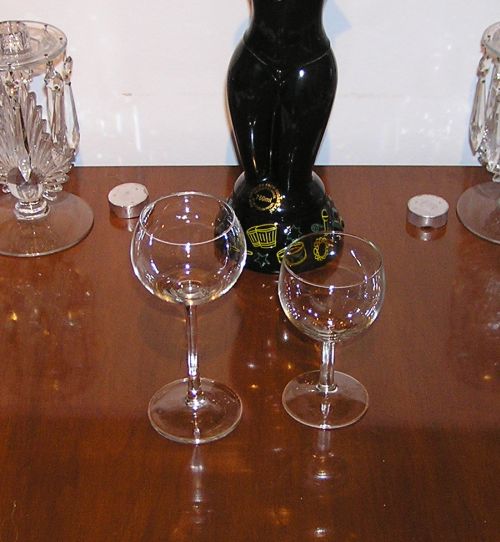
The IKEA Optimol (left) and Reko
These are wonderful compromises between a narrow tulip and Ed's potato launcher (particularly the tall stem on the left with its well rounded bowl and relatively wide mouth). The tall glass is the 7 oz. OPTIMOL dessert wine glass - $1.99 (model 100.919.24). The shorter stem is the 5 oz. REKO wine glass - $2.99 for six (model 201.105.21).
Note: both d/c'd today, but remember the tall glass on the left. You may find a lookalike!
The tall OPTIMOL (on the left) is the favorite for both me and dear Sue Sea. Here's why:
1. It is a beautiful, tall and elegant glass, and at a price even a cheepskate like me can afford.
2. It is small enough (7 oz) that tasting amounts (15-20ml) provide sufficient aroma, yet will certainly handle a full ounce for just plain sipping pleasure.
3. The relatively wide mouth and squat, nicely rounded bowl allows you to tip and access the glass sufficiently to use Ed's high/low nosing technique, while retaining plenty of aroma.
4. The longer stem permits great viewing of color and "legs", and permits palming to add some aroma and sweet releasing heat.
5. Last, and most important, rum simply tastes great out of this glass, better than any glass I've ever tried.
Do note that the shorter stemmed version (right), though noticeably less rounded, may be an option for those who desire a shorter stem. I still have a strong interest in trying both large and small snifters. As for you here's what I recommend:
The glass you use will determine your rum experience and enjoyment.
Buy and try these four glasses:
1. A copita shape, no more than 6 oz.
2. An ordinary straight-sided tumbler, about 3 in. in dia and no more than 2-1/2 in. high.
3. Large snifter
4. IKEA Optimol dessert wine glass, tall stem, 7 oz. (HIGHLY RECOMMENDED)
Learn and use the nosing/tasting technique in Chapter Four. Up spirits!
Capn Jimbo's meticulously handselected list of the world's rons, rums, rhums and cachaca. Mail me one that isn't there and get special recognition and a prize from moi...
